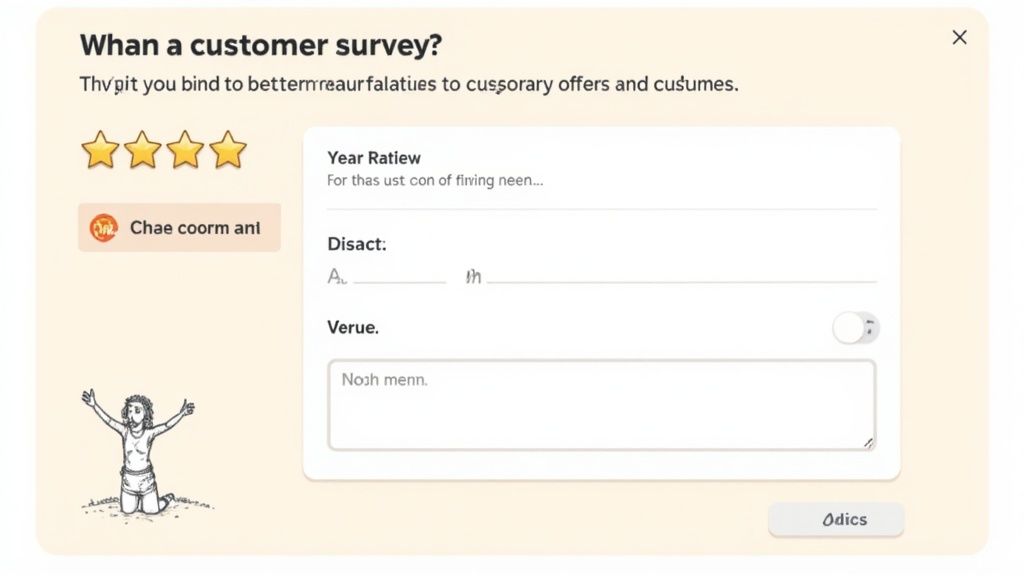Understanding Why Customers Share (Or Stay Silent)

Getting meaningful customer feedback starts with understanding what drives people to share their experiences – and more importantly, what keeps them quiet. Many businesses mistake silence for satisfaction, but research tells a different story: 96% of unhappy customers simply leave without saying anything. This creates a major blind spot, as companies miss out on valuable insights that could help prevent customer losses. Let's explore what motivates customers to speak up or stay silent, and how businesses can encourage more open communication.
The Silent Majority: Decoding the Reasons Behind Non-Response
Several key factors influence why dissatisfied customers often choose to stay quiet rather than provide feedback. Most commonly, customers feel that giving feedback takes too much time and effort – filling out a survey or writing a review feels like an extra task in their busy day. Many also doubt whether their input will make any real difference, especially if past feedback seemed to go nowhere. For example, if a customer previously reported an issue and got a slow or unhelpful response, they're much less likely to bother reporting problems in the future. When customers don't believe their voice matters, silence becomes the easier option.
Motivating Customers to Speak Up: Building Trust and Value
Companies can overcome these barriers and get more customers to share their thoughts. The key is building trust by showing customers their feedback truly matters. This happens when businesses are open about how they use customer input and clearly demonstrate the changes they make based on feedback. A great example is publicly acknowledging when customer suggestions lead to product improvements or service changes. Making the feedback process quick and simple is also essential – short surveys, easy-to-use feedback buttons, and personalized outreach can boost participation significantly.
The Power of Positive Reinforcement: Recognizing and Rewarding Feedback
When companies actively recognize and reward customer feedback, it creates a positive cycle where more customers want to participate. While offering monetary incentives can work, simple gestures often matter more – a genuine thank you message, personal follow-up, or public acknowledgment on social media shows customers their input is valued. Just as online communities thrive on upvotes and recognition for helpful contributions, businesses can apply this same principle to customer feedback. Making customers feel appreciated transforms feedback from an obligation into a meaningful exchange. This leads to more frequent and insightful responses that help companies improve continuously while building stronger customer relationships.
Selecting Your Feedback Channel Arsenal
Getting honest feedback from customers requires building trust and showing you value their input. But just as crucial is choosing the right mix of feedback channels to reach your diverse customer base effectively. Each feedback method, from traditional surveys to modern social listening tools, provides unique insights into the customer experience. When used together strategically, they give you a complete picture of how customers perceive your business.
Matching Channels to Your Audience and Goals
Getting started requires understanding who your customers are and how they prefer to communicate. For example, younger customers may be more likely to provide feedback through social media or mobile apps, while business clients often respond better to personalized emails or phone calls. Your objectives matter too. Quick pulse checks work well with short online surveys, while in-depth interviews or focus groups help uncover deeper insights about specific issues or experiences.
Exploring the Spectrum of Feedback Channels
Each feedback channel brings distinct advantages to the table. Face-to-face interactions, while requiring more resources, tend to get excellent response rates around 57% and allow for detailed conversations. Traditional mail surveys still perform surprisingly well at about 50% response rates for certain demographics. Email and online surveys typically see around 30% participation, though this drops by 17% when surveys take over five minutes. Phone and in-app surveys generally get lower engagement at 18% and 13% respectively, perhaps because customers find them more intrusive. Social media monitoring adds another layer by capturing real-time sentiment and discussions about your brand.
Optimizing Your Feedback Mix: A Real-World Example
Consider an online store's approach to gathering customer input. They might use short post-purchase surveys to check satisfaction right after orders, encourage product reviews on their site and social platforms to build social proof, monitor social media mentions to spot emerging issues, and send periodic email surveys to dig deeper into specific parts of the buying journey. This multi-channel strategy helps paint a complete picture of the customer experience while showing customers their opinions truly matter. When customers see you actively listening and making improvements based on their feedback, they're more likely to keep sharing their thoughts. This creates an ongoing cycle of insights that helps you stay ahead of customer needs and outpace competitors.
Crafting Questions That Drive Meaningful Responses

Getting useful customer feedback starts with asking good questions. The art of survey design involves understanding what motivates customers to provide thoughtful answers, rather than rushing through or abandoning surveys entirely. Success comes down to both what you ask and how you phrase your questions.
Balancing Quantitative and Qualitative Data: Asking the Right Questions
Well-designed surveys use both quantitative and qualitative questions to paint a complete picture of customer perspectives. Quantitative questions, like rating scales and multiple choice, give you measurable data to track changes over time. For example, you might ask customers to rate product satisfaction from 1-5. Qualitative questions, on the other hand, let customers explain their thinking in their own words – like describing their experience with a particular feature. Together, these question types help you understand not just what customers think, but why they feel that way.
Avoiding Common Pitfalls in Question Design
Several mistakes can reduce the quality of feedback you receive. Leading questions that hint at a preferred answer will skew your results. Double-barreled questions that combine multiple issues, like "How satisfied are you with our product's price and features?", confuse respondents and muddy the data. Complex or jargon-heavy language can frustrate customers and lead them to abandon surveys. Given that email surveys typically see only a 24.8% response rate, which drops by 17% for surveys over 5 minutes or 12 questions, keeping things clear and concise is essential.
Examples of Effective Feedback Questions
Good feedback questions focus directly on specific aspects of the customer experience. Here are some examples to consider:
- Quantitative: "On a scale of 1 to 5, how satisfied were you with your recent purchase?"
- Qualitative: "What could we have done to improve your experience today?"
- Specific Feature Feedback: "How easy was it to use the new search function on our website? (Very Easy, Easy, Neutral, Difficult, Very Difficult)"
- Open-Ended for Improvement: "What specific suggestions do you have for improving our product/service?"
When you ask clear, focused questions and avoid common survey design mistakes, you can gather meaningful insights that help improve your business and strengthen customer relationships. Remember that the goal isn't just collecting feedback – it's understanding and acting on what customers tell you. This shows customers their input matters and encourages ongoing dialogue that benefits everyone.
Mastering the Art of Perfect Timing
When collecting customer feedback, the timing of your request can make all the difference in both the quality and quantity of responses. Your customers interact with your business at many different points in their journey – choosing the right moment to ask for their input helps ensure you get meaningful insights that can drive real improvements.
Identifying Optimal Feedback Windows
The customer journey offers multiple natural opportunities to gather feedback. Right after a purchase, customers are ready to share their initial thoughts about the buying experience. A simple question like "On a scale of 1 to 5, how satisfied were you with your recent purchase?" can provide valuable data at this stage. As customers spend more time with your product or service, you can follow up with deeper questions about specific features and functionality.
You can also tie feedback requests to key actions customers take. For instance, after someone uses an important feature in your software, a quick pop-up asking "How easy was it to use this feature?" helps you understand their experience while it's still fresh in their mind. This approach gives you focused insights about specific aspects of your product or service.
Automating Requests Without Losing the Personal Touch
Though automation helps streamline feedback collection, keeping communications personal is key. Generic, automated messages often get ignored. Instead, customize your automated requests by including the customer's name and mentioning their specific interactions with your business. Just as a handwritten thank you note means more than a form letter, personalized feedback requests show customers you value their individual experience and encourage thoughtful responses.
Finding the Right Balance: Respecting Customer Time
While customer insights are important, sending too many feedback requests can backfire. Frequent surveys lead to fatigue and lower response rates over time. Well-timed, occasional requests show you respect your customers' time while still gathering the input you need. Consider spacing out surveys monthly or quarterly, focusing on different aspects of the customer experience each time. Remember that the goal is building genuine dialogue with customers, not just collecting data points.
Building Your Feedback Technology Stack

Getting useful customer feedback requires more than just asking good questions. You need the right tools to collect responses, analyze data, and take action on what you learn. The key is building a technology setup that fits your needs now while being flexible enough to grow with your business. Let's explore how to create a system that makes feedback collection smooth while keeping customer interactions genuine and meaningful.
Essential Components of a Modern Feedback System
A complete feedback system needs several key pieces working together to gather and use customer input effectively:
-
Survey Platforms: Tools like SurveyMonkey and Typeform help you build and send different kinds of surveys. You can use simple rating questions or detailed questionnaires, with features that show different questions based on previous answers.
-
Feedback Widgets: Small tools embedded in your app or website let customers share thoughts right when they're using your product. These catch both numbers-based data and written comments to show exactly how people feel about their experience.
-
Social Listening Tools: Services like Brand24 and Mention watch what people say about your brand on social media. This helps you spot trends and address issues quickly, based on real customer conversations.
-
CRM Integration: Connecting your feedback tools to your customer database helps you personalize outreach and understand feedback context. For example, linking Intercom ratings to Slack through SupportMan lets support teams quickly handle negative feedback with full customer history.
-
Analytics Dashboards: These tools turn raw feedback into clear insights by showing patterns and areas needing work. They help you understand not just what customers think, but why they feel that way.
Choosing the Right Tools for Your Business
The tools you pick should match your company's size, budget and specific needs. A small online store might just need basic surveys and website feedback forms. Bigger companies often need more complete solutions with social monitoring and customer database connections. For instance, a startup could use SurveyMonkey for post-purchase feedback, while larger software companies might want in-app feedback plus dedicated platforms to track overall customer sentiment. Keep in mind that email surveys typically get responses from about 25% of customers – factor this in when planning your approach.
Automating Feedback While Maintaining Authenticity
While automated tools make feedback collection easier, keeping the human touch is crucial. Personalize your automated messages by using customer names and mentioning specific interactions they've had. Just as timing affects response rates, the tone of your messages matters too. Show customers you value their unique experiences and want thoughtful input. This personal approach, combined with good technology, helps turn basic feedback into valuable insights that improve your business and strengthen customer relationships.
Turning Customer Insights Into Business Growth

Getting customer feedback is just the beginning. The real value comes from carefully analyzing that feedback and using it to make meaningful improvements that help your business grow. This means taking a structured approach to understanding what customers are telling you, deciding which changes to prioritize, and putting those insights into action. Let's explore how successful companies turn raw customer feedback into practical strategies that build stronger relationships and drive better business results.
Analyzing Feedback Patterns: Identifying Key Trends and Themes
Making the most of customer feedback requires looking beyond individual comments to spot recurring themes that point to bigger opportunities or problems. For example, when multiple customers mention having trouble finding things on your website, it's a clear sign you need to improve navigation. To identify these patterns, you'll need to organize feedback from various sources like surveys, reviews, and social media in a way that makes trends easy to spot. This could mean adding tags to feedback, using tools to analyze sentiment, or manually reviewing responses to find common threads.
Prioritizing Improvements: Focusing on High-Impact Changes
Not every piece of feedback deserves equal attention. Smart companies focus on changes that will make the biggest difference for both customers and the business. For example, fixing a major bug that many users report is more important than tweaking a minor design element mentioned by just a few people. When deciding what to work on first, consider factors like how often an issue comes up, how it affects customer retention, and what it would take to fix it. A simple matrix comparing potential impact versus effort needed can help guide these decisions.
Implementing Changes and Measuring Results: Demonstrating the Value of Feedback
After identifying and prioritizing key improvements, the next step is putting them into practice and tracking their impact. This might mean testing different website layouts, adding new product features based on customer suggestions, or updating customer service practices. By measuring key metrics before and after making changes – like satisfaction scores, conversion rates, or customer retention – you can see if the improvements are working as intended. This data-driven approach helps you refine your strategy and show stakeholders the concrete value of listening to customers.
Communicating Improvements: Closing the Feedback Loop
A key part of using customer feedback well is telling customers about the changes you've made based on what they told you. This shows them their opinions matter and builds trust. You can share updates through email, your website, social media, or release notes highlighting customer-inspired changes. Being open about how feedback leads to specific improvements encourages more customers to share their thoughts. This ongoing conversation helps build loyalty and creates more chances to learn what customers need and want. Remember that gathering and acting on customer feedback should be a continuous process, not something you do once and forget.
Looking to streamline your customer feedback process and transform insights into action? SupportMan integrates Intercom ratings directly into Slack, empowering your support team to respond quickly to feedback and drive continuous improvement. Try SupportMan's free trial today – no credit card required: https://supportman.io


